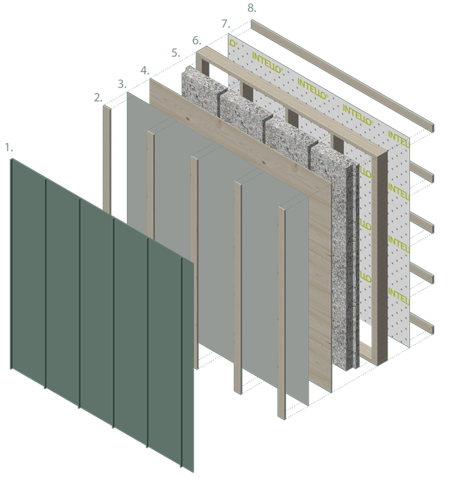Blog
Could panelized retrofits bring Canada’s municipally owned buildings to net-zero carbon?
When considering climate action, you might consider building new solar panels, wind turbines, and green fuel infrastructure. But what about maintaining the infrastructure we already have? In Canada, buildings are responsible for about 15% of Canada’s greenhouse gas emissions, and the portion is even larger in provinces that use fossil fuels to heat buildings. We could tear down those existing buildings and build to net-zero, but that would be 11,000 times more expensive than simply retrofitting those buildings (yes, that’s math, not hyperbole).[i]
Even if every new building is Net-Zero Energy (a building that can produce as much clean energy as it consumes), most of the buildings standing today will still be in use in 2050 , and those buildings will need to be Net-Zero Carbon along with the rest of the country (or sooner, as per the recent IPCC report).[1][2]
According to Efficiency Canada’s 2020 report about the much-needed Deep Retrofit Revolution, the annual retrofit rate needs to be increased from 1% of Canada’s building stock to closer to 12%.
To implement retrofits at this scale, we need a retrofit solution that meets multiple criteria:
- Minimal occupant displacement
- Conventional deep retrofit approaches make buildings uninhabitable for the duration of the project. The logistics of relocating the occupants for every retrofit are not achievable.
- Relatively short implementation time
- Deep retrofits take many months or years. They must be much faster and more efficient to scale from 1% to 12%.
- Affordable
- The business case for retrofits must be attractive to property owners. Owners are looking for a particular ROI, but simple payback on investment does not accurately measure retrofit benefits. Business cases must be more robust and describe the owners of the many benefits of retrofits.
- Climate and weather-resilient
- The retrofit must lead to a building that can withstand and protect people from the increasingly extreme weather events caused by climate change. Concurrently, to deliver more retrofits, the retrofit process itself would be improved if it were less weather dependent.
- Low-embodied carbon
- With the short time remaining to limit the impacts of climate change, it is not responsible to complete retrofits that reduce long-term operational emissions while emitting high up-front embodied carbon. Materials used in retrofits must emit the lowest possible carbon, so the construction emissions don’t offset the intended GHGs saved through the retrofit.
- Aesthetics
- Beauty is an essential part of sustainability. Beautiful buildings will be cared for and increase the well-being and dignity of those who experience them.
In response, ReCover decided to research external panelized retrofits, a technical solution that has shown promise in other regions of the world.
This project studied the potential to use panelization to perform deep retrofits on six municipally owned buildings. Despite challenges adapting to Canada’s diverse buildings and climates, some Canadian projects successfully implemented panelized retrofit technology .[ii][iii]
The project objectives were to make deep retrofits in Canada more feasible, showcase a panelized retrofit approach, and enhance confidence in this approach. It aimed for retrofit designs that can achieve at least a 50% reduction in energy use intensity (EUI), a Net-Zero Energy ready (NZER) scenario with potential for Net-Zero Energy (NZE) performance through solar PV, minimal disruption to occupants, low embodied carbon solutions, cost-effectiveness, and a payback period of 20 years or less.
ReCover partnered with six municipalities, each choosing one building for ReCover to study. The municipalities cover three different Canadian climate zones. Any nationally implemented retrofit solution should work in most, if not all, climate zones.
The buildings were as follows:
- Burlington, Ontario: Burlington Seniors Centre
- Colchester, Nova Scotia: Debert Water Utility Building
- Halifax, Nova Scotia: Harrietsfield Williamswood Community Centre
- New Glasgow, Nova Scotia: Municipal Operations Building
- Oakville, Ontario: Sir John Colborne Recreation Centre for Seniors
- Saskatoon, Saskatchewan: Access Transit Bus Storage and Dispatch Building
THE DESIGN
The Panels
ReCover used a standard wall panel design for each building, as illustrated in the image below. The insulation depth in the panels can be varied based on the desired performance, so the R-values of the panels varied for each building. Each building also had a different suggested exterior metal cladding.

The various components are as follows (referencing the labels in the image):
- Metal cladding
- Rainscreen cavity
- Water Resistive Barrier (WRB) membrane
- Plywood sheathing
- Dense-packed cellulose
- Framing
- Variable permeability vapour control membrane
- Interior strapping
Even with careful investigation, it may not be possible to conclusively determine if components in existing walls inhibit vapour from passing through. For this reason, the team needed to design the panel to dry outward to mitigate risks from moisture build-up and rot. The team chose materials that minimized embodied carbon, using wood for the frame and cellulose insulation, which stores carbon within the panel structure.
The Mechanicals
In three studies, the team recommended a fuel switch to either air or ground source heat pump systems. In one of the buildings, the team recommended a switch from an oil-fired boiler to an electric boiler. The team recommended keeping the existing oil boilers in the remaining two scenarios. These systems will ultimately need to be electrified in the future to meet net-zero targets; however, the business case needed to be stronger to change them as part of this project.
Each project was recommended a 90% efficiency enthalpy recovery ventilation system (ERV), and five of the six were recommended to install a solar PV system.
The Business Case
Evaluation measures focusing on simple payback and short-term return on investment are counterproductive with assets as long-lasting as buildings. Economic evaluation through Total Cost of Building Ownership (TCBO) analysis is more appropriate for complex retrofit projects that change multiple interrelated building systems. Using TCBO allows us to understand the costs of the WHOLE building based on all major building operating and maintenance costs, including:
- Utilities and Operational and Material Carbon Emission Costs
- Age-related component Maintenance & Renewal
- Mortgage Interest
- Insurance
- Property Tax
- Transition to renewable heating energy
This analysis estimates the years it takes for the savings from a retrofit to exceed the costs of doing nothing. The retrofit cases studied had less-than-desirable TCBOs, and the projects were projected to take between 30 years or even up to more than 60 years before the savings exceeded the costs of business as usual.
OUR TAKEAWAY
Until panelized retrofits are scaled, these one-off projects do not have a good business case. Our team was aiming for a payback that was better than 20 years. However, we did demonstrate promising greenhouse gas emissions savings and created beautiful designs that, should they be implemented, will bring the buildings into the next long chapter of their lives with minimal disruption to occupants.
ReCover’s assumptions were that buildings with simple forms and high maintenance deficits would make for better business cases. Despite the financial findings of these studies, we believe additional research is needed to understand the best candidate buildings for panelized retrofits.
[1] https://www.cagbc.org/why-green-building/retrofits-for-the-future/
[2] https://press.un.org/en/2023/sgsm21730.doc.htm
[i] Efficiency Canada, “Canada’s Climate Retrofit Mission: Why the climate emergency demands an innovation-oriented policy for building retrofits”, July 2021, Pg. 17, https://www.efficiencycanada.org/retrofit-mission/
[ii] https://sundancecoop.org/sundance-retrofit-project/
[iii] https://www.och-lco.ca/corporate-information/environment-and-sustainability/
S'inscrire
Rejoindre la conversation!
Inscrivez-vous pour recevoir les dernières nouvelles et mises à jour sur les événements de QUEST Canada et recevez la newsletter mensuelle de QUEST Canada.


